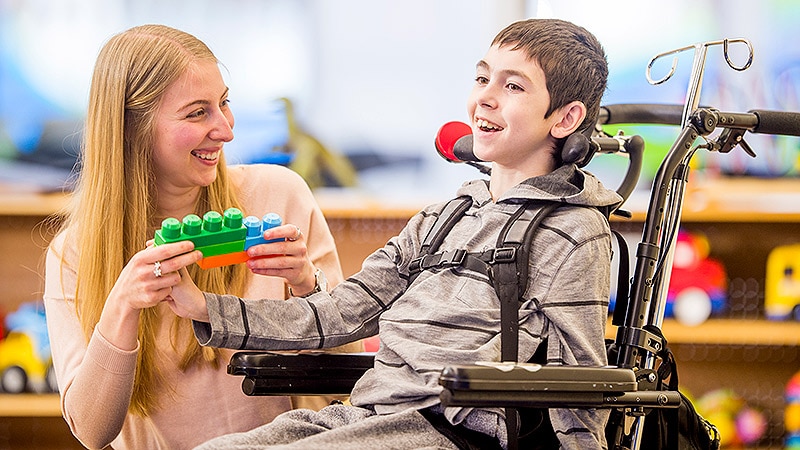Genetic Factors Significantly Contribute to Cerebral Palsy Risk, Whole-Genome Sequencing Study Reveals
Temel Kavramlar
Genetic variations, including de novo and mitochondrial DNA mutations, play a significant role in the development of cerebral palsy, according to a large-scale whole-genome sequencing study.
Özet
This study analyzed the DNA of 327 children with cerebral palsy and their biological parents, as well as two pediatric control cohorts, using whole-genome sequencing. The key findings are:
- 11.3% of the children with cerebral palsy had a genomic variation that likely contributed to their risk of developing the condition.
- Another 17.7% had variants of uncertain significance.
- The study found a high prevalence of de novo variations, which are more likely to cause complications.
- Mitochondrial DNA mutations were identified in 1.5% of the study cohort, suggesting the importance of considering mitochondrial function in cerebral palsy research and clinical settings.
- The genetic insights could inform treatment plans, provide more specific diagnoses, and improve family counseling for children with cerebral palsy.
- The researchers plan to continue this work with a larger, international cohort to further understand the genetic basis of cerebral palsy and explore potential new treatments.
Özeti Özelleştir
Yapay Zeka ile Yeniden Yaz
Alıntıları Oluştur
Kaynağı Çevir
Başka Bir Dile
Zihin Haritası Oluştur
kaynak içeriğinden
Kaynak
www.medscape.com
Genetic Variants May Contribute to Cerebral Palsy
İstatistikler
11.3% of children with cerebral palsy had a genomic variation that likely contributed to their risk.
17.7% of children with cerebral palsy had variants of uncertain significance.
Mitochondrial DNA mutations were identified in 1.5% of the study cohort.
Alıntılar
"That's quite high, and it tells us that genetic risk is something that we need to think about when we're doing a workup for children with cerebral palsy."
"This is a really nice opportunity to bring precision health to cerebral palsy."
"Many parents want to understand why their child has developed cerebral palsy. Getting information on the genetic contribution can help demystify the condition."
Önemli Bilgiler Şuradan Elde Edildi
by Gwendolyn Ra... : www.medscape.com 04-09-2024
https://www.medscape.com/viewarticle/genetic-variants-may-contribute-cerebral-palsy-2024a10006p2
Daha Derin Sorular
How can the genetic insights from this study be leveraged to develop targeted interventions or therapies for children with cerebral palsy?
The genetic insights from this study can be instrumental in developing targeted interventions or therapies for children with cerebral palsy by identifying specific genetic variations that contribute to the condition. Understanding the genetic basis of cerebral palsy can lead to the development of personalized treatment plans based on an individual's genetic profile. For example, if a child is found to have a genetic variant that affects dopamine production, like in the case of dopa-responsive dystonia mentioned in the study, targeted therapies such as L-dopa treatment can be prescribed to improve their condition significantly. By tailoring interventions to the genetic makeup of each child, healthcare providers can optimize treatment outcomes and potentially improve quality of life for children with cerebral palsy.
What are the potential limitations or confounding factors in using whole-genome sequencing to identify genetic contributors to cerebral palsy, and how can future studies address these challenges?
While whole-genome sequencing is a powerful tool for identifying genetic contributors to cerebral palsy, there are potential limitations and confounding factors that researchers need to consider. One challenge is the interpretation of variants of uncertain significance, which were found in 17.7% of the children with cerebral palsy in the study. These variants may not have a clear link to the condition and could lead to uncertainty in clinical decision-making. Additionally, the complexity of the human genome and the presence of genetic modifiers can make it challenging to pinpoint the exact genetic factors contributing to cerebral palsy.
Future studies can address these challenges by incorporating larger sample sizes to increase statistical power and improve the accuracy of genetic associations. Collaborative efforts across multiple research institutions can help validate findings and reduce the impact of false positives. Utilizing functional genomics approaches to understand the biological consequences of genetic variants can also enhance the interpretation of sequencing data. Moreover, integrating other omics data, such as transcriptomics and epigenomics, can provide a more comprehensive view of the molecular mechanisms underlying cerebral palsy.
Given the complex interplay between genetic and environmental factors in the development of cerebral palsy, what research approaches could help elucidate these interactions and their implications for prevention and management?
To unravel the complex interplay between genetic and environmental factors in the development of cerebral palsy, researchers can employ interdisciplinary research approaches that integrate genetics, epidemiology, and environmental science. Longitudinal cohort studies tracking children from birth can help identify early genetic and environmental risk factors associated with cerebral palsy. By collecting detailed information on prenatal and perinatal exposures, researchers can assess how these factors interact with genetic predispositions to influence disease outcomes.
Furthermore, functional studies using animal models or cellular systems can elucidate the biological mechanisms through which genetic variants and environmental exposures contribute to cerebral palsy. Investigating gene-environment interactions at a molecular level can provide insights into the pathways involved in the pathogenesis of the condition. Epidemiological studies that consider gene-environment interactions can also inform strategies for prevention and management of cerebral palsy. By understanding how genetic and environmental factors converge to impact disease risk, healthcare providers can implement targeted interventions to reduce the incidence and severity of cerebral palsy.
0
